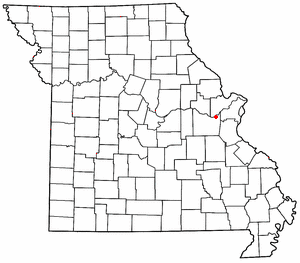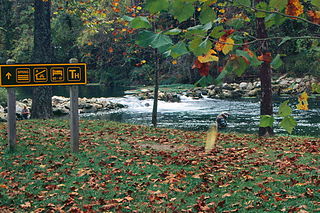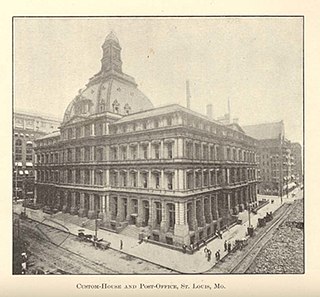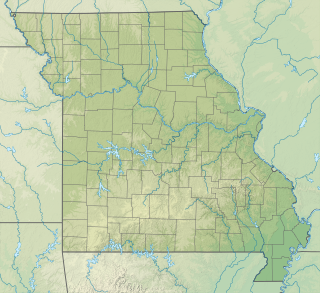
The flag of Missouri, often referred to as the Missouri flag, is the state flag of the U.S. state of Missouri. It consists of three equal horizontal tribands of red, white, and blue stripes, with the arms of Missouri in the center. Designed by Mary Elizabeth Oliver, the red and white stripes, as is traditional, represent valor and purity, respectively. The blue represents three things: the permanency, vigilance, and justice of the state. The three colors also highlight the French influence on the state in its early years. The Missouri flag was established on March 22, 1913, when governor Elliot Woolfolk Major signed the State flag act making it official.

The Missouri Botanical Garden is a botanical garden located at 4344 Shaw Boulevard in St. Louis, Missouri. It is also known informally as Shaw's Garden for founder and philanthropist Henry Shaw. Its herbarium, with more than 6.6 million specimens, is the second largest in North America, behind that of the New York Botanical Garden.

Shiloh Indian Mounds Site (40HR7) is an archaeological site of the South Appalachian Mississippian culture. It is located beside the Tennessee River on the grounds of the Shiloh National Military Park, in Hardin County of southwestern Tennessee. A National Historic Landmark, it is one of the largest Woodland era sites in the southeastern United States.

The Missouri State Capitol is the building that houses the Missouri General Assembly and executive branch of the government of the U.S. state of Missouri. Located in Jefferson City at 201 West Capitol Avenue, it is the third capitol in the city after the other two were demolished when they were damaged in fires. The domed building, designed by the New York City architectural firm of Tracy and Swartwout, was completed in 1917.

Labadie is an unincorporated community in Franklin County, Missouri, United States. It is located approximately three miles north of Gray Summit.

Bennett Spring State Park is a public recreation area located in Bennett Springs, Missouri, twelve miles (19 km) west of Lebanon on Highway 64 in Dallas and Laclede counties. It is centered on the spring that flows into the Niangua River and gives the park its name. The spring averages 100 million gallons of daily flow. The park offers fly fishing, camping, canoeing, hiking, and other activities.

Missouri Valley College is a private liberal arts college that is affiliated with the Presbyterian Church (USA) and located in Marshall, Missouri. The college was founded in 1889 and supports 40 academic majors and an enrollment close to 1,500 students. Missouri Valley College is accredited by the Higher Learning Commission, a Commission of the North Central Association of Colleges and Schools.

The Dr. Generous Henderson House is a historic home located at 1016 The Paseo, once one of the most prestigious areas of Kansas City, Missouri.

The U.S. Custom House and Post Office is a court house at 815 Olive Street in downtown St. Louis, Missouri.

Roaring River State Park is a public recreation area covering of 4,294 acres (1,738 ha) eight miles (13 km) south of Cassville in Barry County, Missouri. The state park offers trout fishing on the Roaring River, hiking on seven different trails, and the seasonally open Ozark Chinquapin Nature Center.

Big Spring is one of the largest springs in the United States and the world. An enormous first magnitude spring, it rises at the base of a bluff on the west side of the Current River valley in the Missouri Ozarks.

The A.W. Patterson House is a historic house in Muskogee, Oklahoma. Located at the intersection of 14th Street and West Okmulgee, it is situated at the crest of a hill near the western edge of the downtown Muskogee neighborhood. It was built in 1906, before Oklahoma achieved statehood in 1907. It was listed on the National Register of Historic Places in 1984.

Sugarloaf Mound is the sole remaining Mississippian culture platform mound in St. Louis, Missouri, a city commonly referred to in its earlier years as "Mound City" for its approximately forty Native American earthen structures.

The Shelby–Nicholson–Schindler House is a "Missouri L-shaped house" in Perryville, Missouri.

The House at 130 Mohegan Avenue, also known as the House of Steel or Steel House, is a prefabricated, modular, International Style house in New London, Connecticut, United States. The House was designed by Howard T. Fisher, who founded General Houses, Inc. in 1932. Winslow Ames, a professor of art history at Connecticut College and the art director of the Lyman Allyn Museum, had the home built after attending the Century of Progress Exposition in Chicago. The House is a single story 21 feet (6.4 m) by 37 feet (11 m) rectangular steel prefabricated home that rests upon a concrete slab. It originally had a flat roof and included an attached garage. Throughout the years, the house has undergone significant alteration, including the addition of a gable roof.

The Doerr–Brown House is a "Missouri German house" in Perryville, Missouri.

Kimball Village is an archaeological site located in the vicinity of Westfield, Iowa, United States. It is one of six known Big Sioux phase villages from the Middle Missouri Tradition that existed between 1100-1250 C.E. The site, located on a terrace overlooking the Big Sioux River, has well-preserved features, including earth lodge and storage pits, and evidence of fortifaction. The site was listed on the National Register of Historic Places in 2010, and as a National Historic Landmark in 2016.

Johnson Morrow House is a historic home located at Callao, Macon County, Missouri. It was built about 1912, and is a two-story, Queen Anne style frame dwelling. The house measures 37 feet by 49 feet and is cubic in shape. It has a complex hipped roof, large side bays, and a full front porch.

Mt. Pleasant Winery Historic District is a historic winery and national historic district located at Augusta, St. Charles County, Missouri. The district encompasses a frame half-timber house with brick outbuilding ; a brick winery building (1881) with a stone well house (1881); and wine cellars. The winery building measures approximately 24 feet by 62 feet, 6 inches, with a 15 foot by 17 foot extension leading to the wine cellars. The wine cellars feature brick floors and brick barrel vaults supported by stone walls.

The Missouri Lumber and Mining Company (MLM) was a large timber corporation with headquarters and primary operations in southeast Missouri. The company was formed by Pennsylvania lumbermen who were eager to exploit the untapped timber resources of the Missouri Ozarks to supply lumber, primarily used in construction, to meet the demand of U.S. westward expansion. Its primary operations were centered in Grandin, a company town it built starting c. 1888. The lumber mill there grew to be the largest in the country at the turn of the century and Grandin's population peaked around 2,500 to 3,000. As the timber resources were exhausted, the company had to abandon Grandin around 1910. It continued timber harvesting in other parts of Missouri for another decade. While some of the buildings in Grandin were relocated, many of the remaining buildings were listed on the National Register of Historic Places in 1980 as part of the state's historic preservation plan which considered the MLM a significant technological and economic contributor to Missouri.























